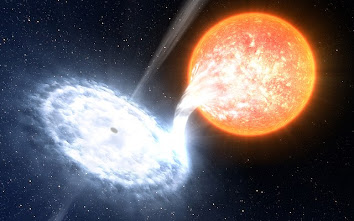A very rare and intense cosmic drama has been captured by NASA’s Hubble Telescope recently. Scientists are using the Hubble telescope to understand what happens when an unpredictable star falls into a black hole.
Black holes are infamous for their exceptional gravitational pull that even light fails to escape. They aren’t hunters but gatherers. They wait for a hapless star to make the mistake of traveling too closely, only to rip it apart violently, spewing out extreme radiation while sloppily ingesting it. In other words, they are messy eaters.
What are Tidal Disruption Events?
Scientists have recorded a star’s final moments in detail as it gets devoured by a black hole, which they call ‘Tidal disruption events’. As extreme as this event sounds, it is quite a rare occurrence as it approximately happens only a few times in every 100,000 years in any given galaxy with a stable supermassive black hole at its core. Astronomers have detected about 100 tidal disruption events so far using various telescopes.

Image credits: Wikimedia commons
Since this star, namely AT2022dsb, is nearly 300 million light-years away at the centre of the galaxy ESO 583-G004, the Hubble telescope cannot take its tidal event’s picture. Astronomers used Hubble’s powerful ultraviolet sensitivity to study the light from the destroyed star constituting hydrogen, carbon, and more. The spectroscopy provided clues to the stellar assassination committed by the black hole.
Star becomes a giant gaseous donut
The All-Sky Automated Survey for Supernovae (ASAS-SN or “Assassin”), a network of ground-based telescopes that surveys the extragalactic sky for violent, variable, and transient cosmic happenings, first caught this AT2022dsb stellar snacking event on 1 March 2022.

Image credits: NASA, ESA, Leah Hustak (STScI)
According to the interpretation of the Hubble spectroscopic data, the former star is now a very bright, hot, doughnut-shaped (torus) region of gas which is as big as the solar system. It is swirling around a black hole at its centre. “We’re looking somewhere on the edge of that donut. We’re seeing a stellar wind from the black hole sweeping over the surface that’s being projected towards us at speeds of 20 million miles per hour (three percent the speed of light),” said Maksym.
Researchers are excited to get the details about what the star debris is doing. This is an exciting place for scientists to be, right at the interface of the known and the unknown as tidal events can reveal a lot about Black holes.
To ‘science-up’ your feed, follow us on Instagram, Facebook or Twitter



4 comments
[…] to combat global warming and climate change. Apparently, humans could generate energy through primordial black holes in the future to meet increasing power demand. Black holes can work as batteries and release energy […]
[…] micro black holes are exceptionally adept at storing energy. Unlike large, standard astrophysical black holes, these micro black holes do not emit Hawking radiation. Furthermore, they do not continuously […]
[…] a solar eclipse, a supernova explosion’s exact time frame is more difficult to determine. NASA estimates it can happen from […]
[…] life cycle due to nuclear fuel depletion and cannot withstand gravitational collapse. The end of nuclear fusion processes or the formation of an iron core are two events that can cause the star’s core to collapse […]